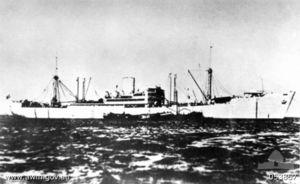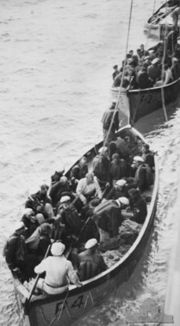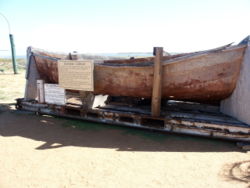Kormorant German Raider And HMAS Sydney
 The auxiliary cruiser Kormoran was a Kriegsmarine (German Navy) merchant raider during World War II.
The auxiliary cruiser Kormoran was a Kriegsmarine (German Navy) merchant raider during World War II.
It was designated as ‘Schiff 41’ and known to the Allied navies as Raider G.
Best known for sinking the Australian light cruiser HMAS Sydney in November 1941 off Western Australia, a battle in which she was also destroyed, Kormoran was a “Handelsstörkreuzer”, or “commerce disruption cruiser”
The ship was built in Kiel and launched on 15 September 1938, as the merchant ship Steiermark of HAPAG.
The disguised freighter
With a displacement of 8,736 tons and a top speed of 18-19 knots, the Kormoran was a prime example of the ‘disguised freighter’ strategy used to disrupt allied shipping.
What was lacking in the heavy armor plating and speed of a conventional warship was made up for by the element of surprise.
 Right: Survivors of Kormoran Being taken on board Centaur.
Right: Survivors of Kormoran Being taken on board Centaur.
The ship was armed with six 150 mm (5.9 in) guns, torpedo tubes and seaplanes.
During her career as a raider, Kormoran sank or captured ten allied ships between 3 December 1940, and 19 November 1941.
Following a battle with the light cruiser HMAS Sydney on November 19, 1941, the ship was sunk about 150 kilometres west of Shark Bay off Australia’s west coast.
Having taken the Sydney by surprise, Kormoran received a number of hits, one of which caused a fire that couldn’t be controlled, it was decided to abandon ship.
Explosive charges were laid to scuttle the ship. About 320 members of the crew are believed to have survived.
The sinking of the HMAS Sydney was the first, and only reported sinking of a major allied warship by a German raider during World War 2.
Sydney and Kormoran Found
It was announced on March 16, 2008 (Australian time) that the Kormoran had been found 5 days previously.
On March 17, 2008, Australian Prime Minister Kevin Rudd announced that the wreck of the HMAS Sydney had been found about 12 nautical miles from the wreck of the Kormoran, and about 8 miles from the scene of the battle.
Was the search worth the expense?
Judging by the response of surviving members of families of the Australian crew that I heard when the news about the finds, I’d have to say definitely, yes, it was worth it.
I would say that the surviving members of the families of the Kormoran’s crew would be just as relieved at the closure this brings!
It brings closure, and may help to explain a mystery that has plagued the country for generations.
The two ships will both be preserved as war graves.
Below: Preserved Kormoran lifeboat at Carnarvon, Western Australia
 Kormoran or Kormorant?
Kormoran or Kormorant?
Over time, Kormoran, Comoran, Cormorant, and Kormorant have all been used when describing the ship.
Although in my previous post I used Kormorant, I believe that Kormoran is the more correct spelling.
Cormoran and cormorant would be the anglicized versions of the names.
More…

There is a lot of talk about the missing lifeboats,5 already found etc but surely the Sydney was fitted out with liferafts for all the crew? I dont think 645 men would fit into 9 lifeboats!
Does anyone know what other floatation devices were fitted to the Sydney, are they still attached,missing or some found onshore somewhere?
G’day Robert,
I guess that the discovery of the Sydney, and the photographs that have been taken since then will raise a lot more questions.
It seems that from the evidence so far though that her captain and crew were definitely taken by surprise.
Cheers
The Kormorant was able to get from the Baltic to the Pacific because of the Hitler-Stalin Pact with the help of Russian advisors and a Russian icebreaker. The German raider was navigated over the north shore of Russia with Soviet support. See “Behind Closed Doors,” a fine documentary by Laurence Rees for BBC/PBS> Tragic to think that the Sydney was sunk because the Australian captain was reluctant to fire on what might be a friendly ship. God rest all their souls.